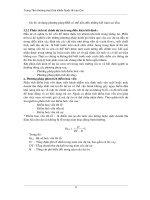ACCA Burying the Billable Hour phần 3 ppsx
Bạn đang xem bản rút gọn của tài liệu. Xem và tải ngay bản đầy đủ của tài liệu tại đây (100.55 KB, 10 trang )
THE DEATH OF COST-PLUS
PRICING
Both Peter Druckers marketing
concept and the Austrian Schools
subjective theory of value spell the
death knell for the billable hour,
which is a derivative of cost-plus
pricing. Contrary to what we were
all taught in our cost accounting
courses, cost does not determine
price in a free market. In fact, cost
may be the least important factor
in determining a price, at the
margin (except as a minimum). At
first this appears to be a heretical
statement; however, when
analysed in the light of the two
theories above, it becomes self-
evident. Here is the internal logic,
side-by-side, of cost-plus pricing
versus Value Pricing:
COST-PLUS PRICING
Product > Cost > Price > Value >
Customers
VALUE PRICING
Customers > Value > Price >
Cost > Product
Notice how Value Pricing
completely reverses the order of
the strategic decisions necessary
in offering products and services to
the marketplace. The traditional
cost-plus theory starts with a
product and asks, How much
does it cost us to produce this
product? The answer dictates the
price, which it is hoped is less
than the perceived value to the
customer. There are two pernicious
effects from this mentality. First,
by merely inflating your overheads
you can increase your firms
revenue a very perverse
incentive given re-engineering,
benchmarking, business model
innovation, and other
management theories designed to
achieve more with less. This is the
main reason cost-plus pricing has
died in defence contracts,
construction, and most other
industries (and never really
applied to intellectual capital
endeavours). Second, your
customers dont care about your
internal costs, nor do they care
about how much money you want
to earn (recall your DNI in the
formula for your standard hourly
rate). It is not the customers
duty to provide us with a DNI. It
PAGE 19
What people really buy: The marketing concept (continued)
is, rather, our job to provide a
service that is so good, they
willingly pay us a profit in
recognition of what we do for
them.
The Value Pricing model, on the
other hand, turns this process
inside out, asking, How much
does the customer value this
offering? Only then is the price
determined, and that price also
dictates the costs that will be
incurred in producing the final
product, ideally at a profit-
optimising level. Despite what your
cost accounting professors
preached, your costs do not
determine your price. Your price
determines your costs.
The business graveyards are full of
companies who had internal costs
and DNIs, who nevertheless went
bankrupt because their offerings
didnt satisfy the expectations of
their customers. Simply having
internal costs and desired levels of
profit is not enough. All
organisations have to create results
outside of themselves, and that is
why the marketing concept along
with the subjective theory of value
rules the business world, and
always will. In the final analysis,
businesses are not paid to control
costs, but rather to create wealth.
Putting price before cost is an
important concept, one that will
take some getting used to in the
day-to-day operation of your firm.
It requires all jobs to be priced
before the work is started, in order
to ascertain that all-important
value perception from the
customers viewpoint. Pricing up-
front also has an effect on human
behaviour, which leads us to our
next topic, price psychology.
PAGE 20
What people really buy: The marketing concept (continued)
People tend to buy emotionally
and justify intellectually, which
makes the study of price
psychology a worthwhile
endeavour. Basically, there are two
characteristics of price psychology:
1.Price leverage.
2.Pricing emotions.
PRICE LEVERAGE
Price leverage does not mean an
advantage possessed by one party
over the other, but rather a
question of who has the most (or
least) price sensitivity at a given
point in time. Before an
engagement begins, the
accountant possesses the price
leverage. This is because the
customer is willing and able to do
business with you (otherwise you
wouldnt have made it this far in
the process) and they desire (or
badly need) the service.
Think of the psychological factors
when the customer is confronted
with an Inland Revenue audit. The
time to negotiate and set the price
for your representation is not after
you have completed the audit, but
before. Once you start, or
complete, an engagement, the
price leverage shifts to the
customer and you are left trying to
recoup any portion of your price
the customer is willing to pay.
This is precisely one of the reasons
why accountants around the world
do not achieve 100% of their
Price psychology
PAGE 21
4
If you are buying an automobile,
do you really care how much time
it took to install the hood of the
car?
(Richard C. Reed, Billing
Innovations)
standard hourly rates. They tend
to set their price after the
engagement has begun or after it
has been completed. This is an
inopportune time to discover that
the customers value perception is
different from yours. It is much
better to learn that perception
before you start the job, so you
can either educate the customer as
to your value, or withdraw from
the engagement.
Hence, the second rule of Value
Pricing is to set prices before the
engagement begins, everywhere,
every time (though there are some
exceptions relating to Change
Orders, which we will discuss in
the next section). This is just
common sense. Everything you
buy as a consumer you know the
price before you purchase. Would
you hand your car mechanic a
blank cheque to tune up your car?
Would you fly on an airline that
wanted to charge you £5 per
minute? Why do we think
accounting services are any
different? The fact is, accountants
are subject to the same laws of
supply and demand, customer
psychology and pricing psychology
as every other business.
The argument that you dont know
how long it will take, and hence
you couldnt possibly quote a
price, is nonsense, and is redolent
of Marxs labour theory of value.
Not knowing the labour time does
not obviate the need to price up-
front, and we ignore this rule at
our own peril, resulting in write-
downs, write-offs and dissatisfied
customers. When you are taking
on a job where you are unsure as
to its scope, the burden is on you
to define that scope, break the job
down into measurable phases, and
issue Change Orders when work
falls outside of your defined scope.
Also, by pricing work up-front, you
can command a risk premium,
exactly the opposite of the hourly
billing method. When you bill by
the hour, you shift all of the
transaction risk to the customer,
thereby lowering your reward.
However, when you offer fixed
prices up-front, you share some of
the transaction risk, and it is well
PAGE 22
Price psychology (continued)
established that customers will
pay to avoid risk (witness the $1.5
trillion worldwide insurance
industry). How much of a
premium can you command by
offering fixed prices? That depends
on your customer, though I have
seen anywhere from 10 to 50%
premiums. If this sounds counter-
intuitive, think about the mortgage
market: which offers a higher rate
of interest, fixed or variable loans?
Why?
PRICING EMOTIONS
There are three primary pricing
emotions each customer will
encounter at various times through
the purchasing cycle. They are:
1.Price resistance.
2.Price anxiety.
3.Payment resistance.
Price resistance is the proverbial
sticker shock an initial reaction
to cost. As long as you are dealing
with people, you are likely to
encounter this emotion. The best
way to overcome it is by educating
the customer as to the value you
provide. Price resistance is usually
encountered at the beginning of
the negotiating process and thus it
is easy to identify. I have found
that in most instances accountants
can overcome this emotion; if you
cant, I would seriously suggest
you not take the engagement. You
do not want to work for people
who dont understand, or refuse to
pay for, the value you provide.
Also, dont worry about inducing
sticker shock by quoting high
prices for your services. Sticker
shock is a healthy emotion, one
that tunes you in to each
customers pricing points. If you
fail to induce sticker shock, you
may be under-pricing your
services.
Price anxiety is also known as
buyers remorse. It is now well-
known that luxury car
advertisements are targeted at
existing owners, more so than
potential owners. This is because
after such a large purchase,
customers want reassurance that
they have made a good decision.
This is a significant psychological
PAGE 23
Price psychology (continued)
emotion that all customers will go
through, especially after entering
into a Fixed Price Agreement (FPA)
with your firm. You can overcome
price anxiety by constantly staying
in touch with your customers,
assuring them they made the right
decision in hiring you by exceeding
their expectations, and offering
total quality service. You can also
offer a 100% money back
guarantee, which dramatically
lowers buyers remorse.
Payment resistance is simply the
customers unwillingness to write
the cheque. Who likes to pay their
bills? Payment resistance is
overcome by involving the
customer in the design, price, and
payment terms of your services.
Once people are committed to a
Fixed Price Agreement, they are
more likely to write the cheque, or
authorise the credit card, in
accordance with the agreement.
All the accountants around the
world who use Fixed Price
Agreements have been very
positive with respect to accounts
receivable collections, and some
firms do not even send monthly
invoices to their FPA customers. In
fact, the accounts receivable
difficulties tend to be with
customers who did not receive a
fixed price before the work began.
We will now turn to implementing
Value Pricing utilising the Fixed
Price Agreement and Change Order
concepts.
PAGE 24
Price psychology (continued)
Successful professional firms of
today are pricing their services
according to external value created
as perceived and determined by
the customer rather than internal
costs incurred in generating those
services. One method that has
been adopted in implementing
Value Pricing is the Fixed Price
Agreement (FPA). Essentially, this
requires meeting your customers to
determine the services they want
and need in the forthcoming year.
It is important to keep in mind that
any FPA that is drafted between
your firm and a customer is the
result of a negotiating process.
This is your chance to provide the
customer with a customised list of
services to meet their specific
needs, wants, expectations, and to
offer a fixed price for those
services, specify the payment
terms, and any other level of
agreement reached. Thus, no two
FPAs should look alike they
should be as unique and individual
as your customers. The more
customised it is, the higher will be
its perceived value.
The following sample FPA (see
Figure 5.1) does not replace your
firms standard engagement letter.
You must still use engagement
letters for each major service you
provide, in accordance with your
professional indemnity insurers
guidelines (for accountants, this
usually means an engagement
letter for each audit, review,
Implementing Value Pricing
PAGE 25
5
If you aim to profit, learn to
please.
(Winston Churchill)
compilation, tax return, and
management advisory service).
The FPA illustrated is only an
outline you will need to tailor it
to make it suitable for your own
company. I have seen hundreds of
FPAs from accounting firms around
the world, and no two look alike. It
needs to be adapted to your firms
culture and personality, as well as
to that of your customers.
ADVANTAGES OF THE FPA
Pre-qualifies the customer
Discovering the customers
perception of value before your
firm commits any resources is
a better strategy than finding out
after the service the customer
has a lower value perception
PAGE 26
Implementing Value Pricing (continued)
than you do, no matter how you
price your services. Discussing
price up-front puts these issues
on the table, and in the long run
will save countless hours spent
in pricing disputes, write-offs,
and other problems that could
have been avoided had there
been better communication at
the beginning of the
engagement.
Opportunity to cross-sell
By brainstorming with the
customer regarding future goals
and aspirations, you will
inevitably learn of many
opportunities to cross-sell your
firms services. You cannot
expect to automatically receive
additional work from the
customer you have to earn it,
by showing that your firm is a
better alternative than the
competition. Empirical evidence
suggests with a Value Pricing
relationship you will be more
successful in obtaining
additional work by focusing on
value.
Value Pricing gains ego
investment from the customer
All of us want to be in control;
this is basic human nature. By
giving customers a sense of
ownership over your firms
services, offering them choices,
and customising your delivery to
meet their needs, you will gain
their ego investment. Once
people make a commitment, by
1 November, 2001
Dear Customer,
In order to document the understanding between us as to the scope of the work that ABC, Accountants will perform, we are
entering into this Fixed Price Agreement with XYZ, Ltd. To avoid any misunderstandings, this Agreement defines the
services we will perform for you as well as your responsibilities under this Agreement.
2002 PROFESSIONAL SERVICES
ABC will perform the following services for XYZ during 2002:
2001 Year End, and End-of-Year PAYE Forms
1st, 2nd and 3rd Quarter Payroll VAT Return
2001 XYZ Corporation Tax Returns
2001 Audited Financial Statements with Lead
Schedules to be provided by XYZ by 15 March 2002
Annual Consulting Service 2002*
TOTAL 2002 PROFESSIONAL SERVICES £ XXX
*Included in the Annual Consulting Service are the following services to be provided by ABC to XYZ:
Unlimited meetings, to discuss operations of XYZ, business matters, tax matters and any other topic at the discretion of
XYZ or its employees and/or agents.
Unlimited phone support for XYZ personnel and/or independent contractors and agents regarding accounting
assistance, recording of transactions, etc.
Because our Fixed Price Agreement provides ongoing access to the accounting, tax and business advice you need on a
fixed-price basis, you are not inhibited from seeking timely advice by the fear of a clock running endlessly. Our services
are designed around fixed prices, as opposed to hourly rates, and offer you access to the accumulated wisdom of the
firm through accountants with substantial experience, who can help enhance your companys future and achieve its
business goals.
Unanticipated Services
Furthermore, the parties agree that if an unanticipated need arises (such as, but not limited to, an audit by a tax authority,
or any other service not anticipated in this agreement by the parties) that ABC hereby agrees to perform this additional
work at a mutually agreed upon price before the service is provided. This service will be billed separately to XYZ, as part
of a Change Order, and will be payable upon presentation (or payable upon terms mutually agreed upon).
Service Guarantee
Our work is guaranteed to the complete satisfaction of the customer. If XYZ is not completely satisfied with the services
performed by ABC, we will, at the option of XYZ, either refund the price, or accept a portion of said price that reflects XYZs
level of satisfaction. We will assume you are satisfied upon final payment received under the terms of this Agreement.
Figure 5.1, Sample Fixed Price Agreement
The following payment plan is hereby agreed to by XYZ and ABC:
January 31, 2002 XX
February 28, 2002 XX
March 31, 2002 XX
April 30, 2002 XX
May 31, 2002 XX
June 30, 2002 XX
July 31, 2002 XX
August 31, 2002 XX
September 30, 2002 XX
October 31, 2002 XX
November 30, 2002 XX
December 31, 2002 XX
TOTAL 2002 PAYMENTS £ XXX
To assure that our arrangement remains responsive to your needs, as well as fair to both parties, we will meet throughout
(monthly, quarterly, or other time schedules agreed to by the parties) 2002 and, if necessary, revise or adjust the scope of
the services to be provided and the prices to be charged in light of mutual experience. [Note: This clause can be used for
new customers your firm is unfamiliar with, or veteran customers you are moving over to the FPA; either way, it lowers
the risk even further for the customer].
Furthermore, it is understood that either party may terminate this Agreement at any time, for any reason, within 10 days
written notice to the other party. It is understood that any unpaid services that are outstanding at the date of termination
are to be paid in full within 10 days from the date of termination.
If you agree that the above adequately sets forth XYZs understanding of our mutual responsibilities, please authorise this
Agreement and return it to our office. A copy is provided for your records.
We would like to take this opportunity to express our appreciation for the opportunity to serve you.
Yours sincerely,
BY:
Partner
ABC, Accountants
Agreed to and Authorised:
BY: DATE:
Customer, Director
XYZ, Ltd.
© 2001 Aspen Law & Business, Professionals Guide to Value Pricing, reprinted with kind permission.









